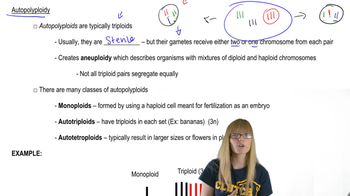The primrose, Primula kewensis, has 36 chromosomes that are similar in appearance to the chromosomes in two related species, P. floribunda (2n=18) and P. verticillata (2n=18). How could P. kewensis arise from these species? How would you describe P. kewensis in genetic terms?
Table of contents
- 1. Introduction to Genetics51m
- 2. Mendel's Laws of Inheritance3h 37m
- 3. Extensions to Mendelian Inheritance2h 41m
- 4. Genetic Mapping and Linkage2h 28m
- 5. Genetics of Bacteria and Viruses1h 21m
- 6. Chromosomal Variation1h 48m
- 7. DNA and Chromosome Structure56m
- 8. DNA Replication1h 10m
- 9. Mitosis and Meiosis1h 34m
- 10. Transcription1h 0m
- 11. Translation58m
- 12. Gene Regulation in Prokaryotes1h 19m
- 13. Gene Regulation in Eukaryotes44m
- 14. Genetic Control of Development44m
- 15. Genomes and Genomics1h 50m
- 16. Transposable Elements47m
- 17. Mutation, Repair, and Recombination1h 6m
- 18. Molecular Genetic Tools19m
- 19. Cancer Genetics29m
- 20. Quantitative Genetics1h 26m
- 21. Population Genetics50m
- 22. Evolutionary Genetics29m
6. Chromosomal Variation
Chromosomal Mutations: Aberrant Euploidy
Problem 22c
Textbook Question
Two experimental varieties of strawberry are produced by crossing a hexaploid line that contains 48 chromosomes and a tetraploid line that contains 32 chromosomes. Experimental variety 1 contains 40 chromosomes, and experimental variety 2 contains 56 chromosomes.
How many chromosomes from the tetraploid lines are contributed to experimental variety 1? To experimental variety 2?
 Verified step by step guidance
Verified step by step guidance1
Step 1: Understand the ploidy levels and chromosome numbers of the parent lines. The hexaploid line has 48 chromosomes, meaning it has 6 sets of chromosomes (48 ÷ 6 = 8 chromosomes per set). The tetraploid line has 32 chromosomes, meaning it has 4 sets of chromosomes (32 ÷ 4 = 8 chromosomes per set). Both lines share the same base chromosome number (8).
Step 2: Analyze the chromosome numbers in the experimental varieties. Experimental variety 1 has 40 chromosomes, and experimental variety 2 has 56 chromosomes. These numbers are derived from contributions by both the hexaploid and tetraploid parent lines.
Step 3: Determine the contribution from the hexaploid line. Since the hexaploid line contributes chromosomes in multiples of 8 (its base chromosome number), calculate how many sets of chromosomes it could contribute to each experimental variety. For variety 1 (40 chromosomes), the hexaploid line could contribute 24 chromosomes (3 sets of 8). For variety 2 (56 chromosomes), the hexaploid line could contribute 48 chromosomes (6 sets of 8).
Step 4: Calculate the contribution from the tetraploid line. Subtract the hexaploid contribution from the total chromosome number in each experimental variety. For variety 1: 40 - 24 = 16 chromosomes from the tetraploid line. For variety 2: 56 - 48 = 8 chromosomes from the tetraploid line.
Step 5: Verify the results. Ensure that the contributions from both parent lines add up to the total chromosome numbers in each experimental variety. For variety 1: 24 (hexaploid) + 16 (tetraploid) = 40 chromosomes. For variety 2: 48 (hexaploid) + 8 (tetraploid) = 56 chromosomes. This confirms the calculations are correct.
 Verified video answer for a similar problem:
Verified video answer for a similar problem:This video solution was recommended by our tutors as helpful for the problem above
Video duration:
3mPlay a video:
Was this helpful?
Key Concepts
Here are the essential concepts you must grasp in order to answer the question correctly.
Polyploidy
Polyploidy refers to the condition of having more than two complete sets of chromosomes. In this case, the hexaploid line has six sets (48 chromosomes) and the tetraploid line has four sets (32 chromosomes). Understanding polyploidy is essential for analyzing the genetic contributions of different parent lines in hybrid offspring.
Recommended video:
Guided course

Autopolyploidy
Chromosome Contribution in Hybridization
In hybridization, the offspring inherit a combination of chromosomes from both parent lines. The total number of chromosomes in the hybrids can be calculated by adding the contributions from each parent. This concept is crucial for determining how many chromosomes from the tetraploid line are present in the experimental varieties.
Recommended video:
Guided course

Chromosome Structure
Chromosome Count Calculation
Calculating the chromosome count involves understanding how many chromosomes each parent contributes to the offspring. For experimental variety 1 (40 chromosomes) and variety 2 (56 chromosomes), we can set up equations based on the known contributions from the hexaploid and tetraploid lines to find the specific contributions from the tetraploid line.
Recommended video:
Guided course

Calculating Heritability
Related Videos
Related Practice
Textbook Question
867
views


